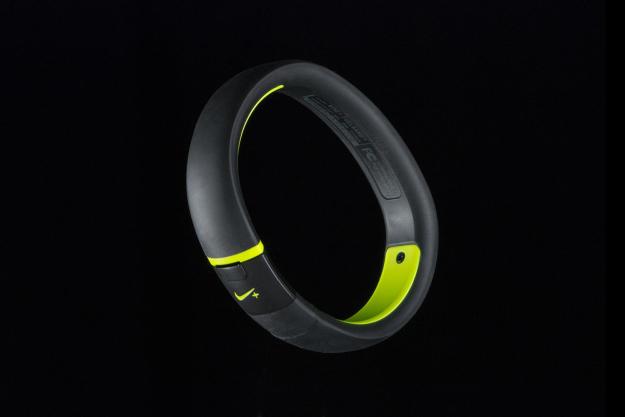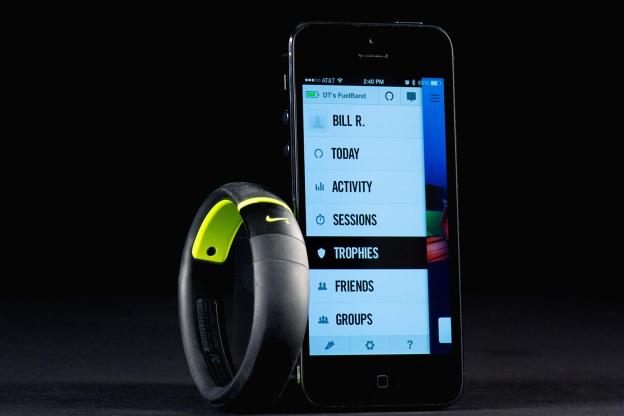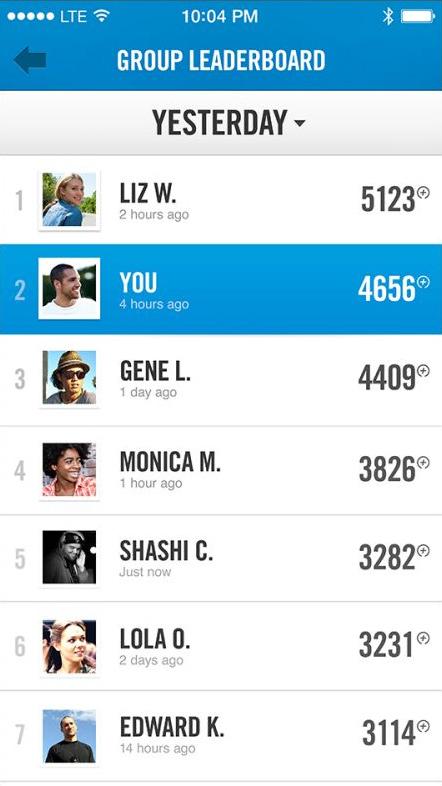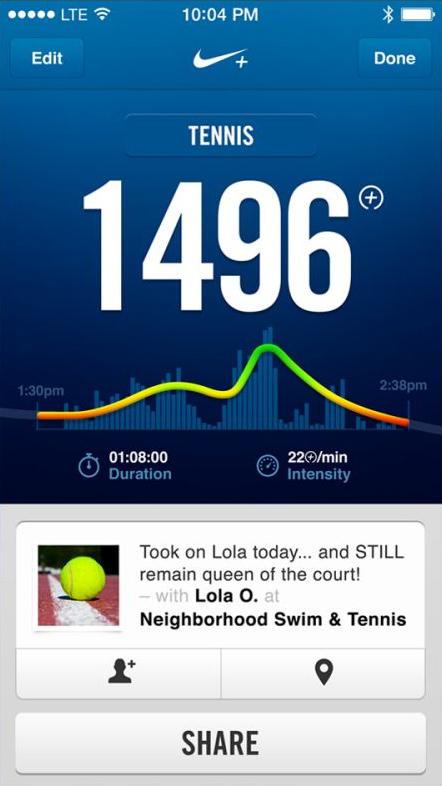
“Despite a number of new features and a slick design, Nike’s Fuelband SE is still not a serious fitness-tracking device.”
- Stunning, stylish design
- Extremely detailed online support
- Wirelessly communicates with iPhone app
- Easy to read display
- No Android app
- Only tracks some types of exercise
- Rigid, bulky, and uncomfortable
As fashion, technology, and fitness continue to converge, users are asking more and more from both their clothing and their digital devices. In this climate, Nike has much to gain by keeping people in swoosh mode 24/7. The company’s latest move in that direction is the new Nike+ Fuelband SE, an improved version of its fitness-tracking predecessor that features better sensors, Bluetooth 4.0, and new features like hourly movement reminders.
A quick survey of #fuelband on Instagram suggests Nike’s fashion-first plan is working. Fans have posted thousands of images of their Nike Fuelbands just as they would any kind of kind of jewelry. Many of them wear the band upside down so the Nike+ logo sits loud and proud up top, the display tucked away on the inside of their wrist. Which makes us wonder: Is the Fuelband SE anything more than a digital fitness fashion statement? Come along to see what we found out.
Features and design
The sleek, futuristic Nike+ Fuelband SE looks more like a Jony Ive “design solution” for handcuffs than it does a fitness device built to record the free-ranging motion of a human body. Technically, it’s not a “band” at all, but what the fashionistas call a “bangle.” Though it looks flexible, the rubberized plastic hoop is quite rigid once the clasp (which doubles as a USB connector) is closed. Unclasp it and it barely opens wide enough to slip a wrist through. Force it open too wide, Nike warns, and the Fuelband can break.
An LED display sits beneath the Fuelband’s translucent top skin, invisible when it’s not illuminated, with a slightly hazy look when it is. A progress bar, color coded red to green, runs below it, and just one button sits to the side.
The mostly black Fuelband bangle is currently available in black on black, or in three other high-viz colorways: yellow, pink, and orange. A new, limited-edition Metalux, series cranks up the fashion aspect with shiny metal accents. The first of these to arrive, the “Rose Gold” model, drops on November 21.
Because of the Fuelband’s rigid design, Nike offers it in small (for most women), medium (for most men) and large (for people over 250 pounds) sizes. Each of the bands is adjustable in 8mm increments using links.
What’s in the box
Nike rivals only Apple in the design and style that goes into the packaging for its technology products. It seems silly to mention, but the Fuelband SE box is as visually stunning and intricately designed as the product itself.

The Fuelband arrives in a completely white box featuring a color photo of the Fuelband below a Nike+ logo embossed in silver. An inner white box slides out of the outer sleeve and swings open like a book to reveal the Fuelband resting in a perfectly fitted indentation on the right, and a small black box on the left, which contains the USB cable, links and sizing tool. You’ll also find a printed quick-start guide that clearly explains how to get the Fuelband up and running – often a rarity in these digital times.
Performance and use
Despite its epic design, the Fuelband does only three things: It tells the time, records motion, and reminds the wearer to get up and walk if they’ve been static for more than an hour. The motion it records is reported back in one of three metrics: Nike’s own NikeFuel points, steps, and calories burned.
The Fuelband has a tough time when it comes to properly recording activities like cycling, weight training, or yoga.
You can keep track of how you’re doing using the LED display, the Fuelband app on your iPhone (sorry Android users), or by plugging the USB connector into a computer, which will push your data to the Nike+ Website. The app, which talks to the Fuelband via Bluetooth 4.0, allows you to view current stats, control the settings on the Fuelband, get performance badges, and share all the data with a social-media stream.
Setting up the Fuelband was a simple four-step process: Create a Nike+ account online with details like age and weight, download the app, install it, and plug in the Fuelband SE. At each step we were impressed by how well everything worked and how helpful Nike+’s online support was when we had any questions. With this out of the way we were ready to begin tracking our activities.
The Fuelband works like most other accelerometer-based fitness trackers. By tracking the movements of the user’s arm, the Fuelband can extrapolate steps taken and calories burned. Nike then uses this motion data to deliver performance numbers in NikeFuel – a nebulous Nike-invented metric. Sure it’s fun to get rewarded for moving and to watch the progress lights slowly fill from red to green over the course of the day, but it is very difficult to understand what NikeFuel is or what it means. You can also see steps taken and calories burned, but not distance travelled.
Since it only has accelerometers, the Fuelband has a tough time when it comes to properly recording activities like cycling, weight training, or yoga. Nike attempted to remedy that with the SE by adding a “Sessions” option, which allows users to track an activity and then “calibrate” the intensity of the workout after it is completed so that proper NikeFuel points can be awarded the next time the activity is performed. While it is entertaining, it seems to add even more fuzz to the already furry NikeFuel numbers.

One feature we found most useful was the reminder to move. If the Fuelband notices that you haven’t moved in an hour it will scroll a message across the display saying “Go [your name] Go [your name]” several times. The personalization is a cute reminder to get away from the screen for a few minutes every hour… if you see it. Without audible or vibrating alerts we rarely saw the reminder to move, unless the Fuelband was paired with an iPhone (where the move notifications come with a sound).
Nike claims the Fuelband “measures all the activities in your active life,” however, the band is only water resistant, not “waterproof.” Nike says that the Fuelband is fine for “showering and washing dishes,” but not so good for the bath tub or for swimming. Our recent experiences with other “water resistant” technology (which we fried by accidentally jumping into a swimming pool) made us wary of getting the Fuelband anywhere near water. This meant removing the Fuelband for showering, swimming, and surfing.
We also ended up removing the Fuelband at night for a number of reasons: It doesn’t track sleep like the Fitbit Force or Jawbone Up, it doesn’t have an alarm, and the stiff band just isn’t that comfortable. The Fuelband incessantly bumped and banged around while we typed, and its rubbery surface also caught constantly on long-sleeved clothing, often wedging itself halfway up on our forearm.
It also takes an inordinate amount of time for the Fuelband to pair with an iPhone. At times, it wouldn’t pair at all, at which point you have to restart the app and reset the Fuelband. One day our pairing problems seemed to coincide with the Nike+ site being down, which appears to happen often according to some messageboard comments.
Even wearing the Fuelband simply as a watch was troublesome after a while. Checking the time requires pressing the Fuelband’s one button, and occasionally scrolling through all the other metrics before getting to the time display. But even when the Fuelband is set on the time function, there is still a lag. Rather than having the time come up after pressing the button, the Fuelband delivers the word “TIME” followed several seconds later by the time of day. Sure, it’s only a three seconds, but waiting three seconds to see the time is ridiculous.
Conclusion
Nike’s Fuelband SE is a delightfully fashionable piece of high-tech jewelry. It makes a strong statement that you’re down with technology, hyped on Nike, and interested in staying fit. Yet, as fun and stylish as the Fuelband SE is to wear, we constantly found ourselves wishing it would do more than encourage us to move, track of our movements, and reward us for moving.
The Fuelband SE shows great potential. None of the fitness-tracking devices we’ve tested so far have made us more optimistic about what a real, functioning smart watch could be. We wish the Fuelband could deliver text messages, remind us of upcoming appointments, and quietly alert us to an incoming phone call, and who was calling. We wanted a vibration mode to remind us to get up and move, and maybe even an alarm on the watch.
But none of this is there yet. And that left us disappointed by the virtually featureless realities of the Fuelband SE itself.
For people living in the Nike+ ecosystem who are interested in getting moving at the office or beginning a more serious fitness program, the Fuelband SE could be the kick they need. For anyone serious about training, however, the Fuelband is not much more than an attractive piece of high-tech jewelry that does some cool tricks.
Highs
- Stunning, stylish design
- Extremely detailed online support
- Wirelessly communicates with iPhone app
- Easy to read display
Lows
- No Android app
- Only tracks some types of exercise
- Rigid, bulky, and uncomfortable







